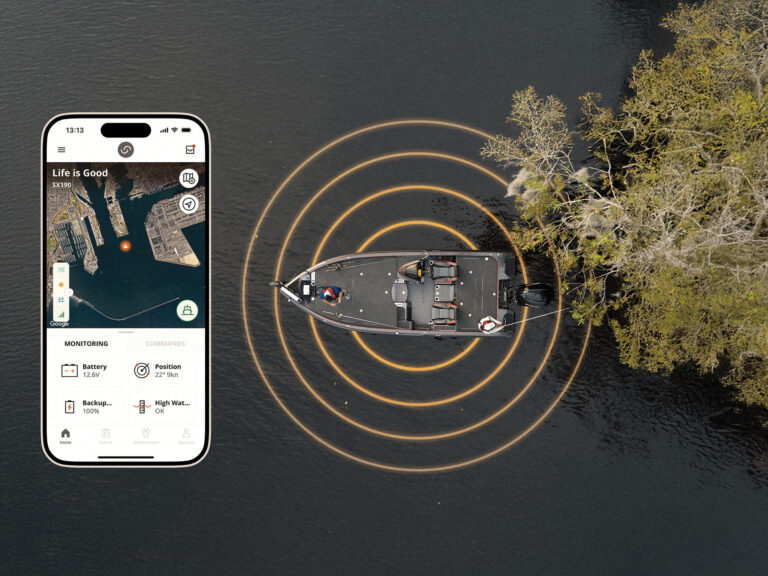
The /SWS/ Bait Encyclopedia
(Hemiramphus brasiliensis) Nicknames: ‘hoo, halfbeak, balao Target species: sailfish, marlin, dolphin, grouper, snapper Collecting: Ballyhoo are caught primarily with castnets. Nearshore schools are attracted to frozen blocks of ground chum suspended off the transom. Ballyhoo will also take small pieces of bait fished on hook and line, although this method yields few baits for the amount of effort. Storing: Ballyhoo adapt easily to live wells, provided the water is exchanged regularly. Many crews also flash-freeze ballyhoo in packs to rig for offshore use throughout the season. John Rice

The /SWS/ Bait Encyclopedia
Rigging: Federal regulations now require the use of circle hooks with bait for billfish tournaments, forcing widespread experimentation (see “Tactics & Tackle,”¿ April 2007), but methods that attach the head of the bait to the bend of the hook using floss or plastic zip-ties remain the go-to rigs. A trolling skirt-and-ballyhoo combination is standard fare for surface-skipping or swimming presentations. Skip the skirt and run ‘hoos “naked”¿ when the fish get wary. Pro Tip: For quick and simple live pitch-baits, wrap a short strand of copper rigging wire around the hook shank just below the eye, leaving a tag end two to three inches long. Run the hook point downward through the lower jaw of a frisky ballyhoo with the hookeye towards the end of the beak. Lock the hook in place by wrapping the wire tag around the beak and the shank several times. The wire often lasts all day and mangled baits can be replaced in under a minute. Scottkerrigan.com

The /SWS/ Bait Encyclopedia
(Glycera dibranchiata) Nicknames: worms, bloods Target species: striped bass, weakfish, fluke Collecting: Bloodworms are commercially harvested and sold to bait and tackle shops. Dig your own from East Coast mud flats at low tide using a worm hoe, but be sure to check with local authorities in advance to make sure it’s legal. Storing: A bucket of moist sand in the shade will keep worms for a few days. John Rice

The /SWS/ Bait Encyclopedia
Rigging: In the summer, when weakfish and stripers stack up around tidal creeks in the back bays, it’s hard to top a good old-fashioned bobber rig and bloodworm. Pin a whole worm on a live-bait hook and fish it anywhere from 12 to 24 inches below a foam float, depending on depth. This rig works particularly well at dusk and dawn in the early stages of the outgoing tide, as the flow sucks forage out of sodbank creeks and into the open bay. Pro Tip: Pros know the beer fridge in the garage is the perfect bait fridge-a good use of space, considering a dozen bloodworms can run upwards of $15. In early striper season, you may only use two or three worms per trip when the bite is slow. Wet their seaweed packing with seawater and refrigerate for up to a week. If worm supplies are limited, visit www.seabait.com and check out their Bloodworm Potion, useful for treating soft-plastics. Dwskok.com
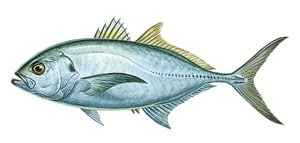
The /SWS/ Bait Encyclopedia
(Caranx crysos) Nicknames: hardtail, runner, ‘tail Target species: king mackerel, cobia, grouper, amberjack Collecting: Blue runners hold close to structure: Navigation aids and oil or gas rigs in the Gulf of Mexico are prime habitat. Multihook Sabiki rigs, bucktails and small, flashy lead minnows jigged vertically will fill the well in short order. Use heavier tackle to pull multiple fish away from barnacle-encrusted structure. Storing: Blue runners are durable in high-volume live wells. Tournament anglers often catch these small jacks days before an event and store them in collapsible mesh or homemade bait wells suspended off docks. John Rice
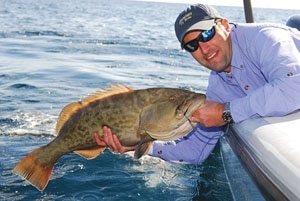
The /SWS/ Bait Encyclopedia
Rigging: Blue runners as kingfish baits are typically rigged on leaders of the lightest-possible wire using haywire twists. A small J-hook through the nostrils or both jaws is connected to a second wire leader. The trailing wire loops through the lead-hook twist loop and ends with a treble-hook stinger embedded lightly in the bait’s side. The stinger wire should be long enough to let the bait swim naturally. Pro Tip: Don’t throw away fresh-dead ‘tails. Bring them back to “life”¿ by cutting each side of the bait from the tail forward as you would a fillet, but leaving the leading end attached near the head. Sever the now-denuded backbone and discard it along with the tail. Tie on a six-ounce white bullet jig with a 10/0 hook and thread a white eight-inch soft-plastic curl-tail grub on the shank. Add the butterflied bait by running the hook point up through the lower jaw and out the top of the head. Drop it over structure and pay attention. Most strikes-from red snapper, cobia or gags-will come on the drop. Scott Sommerlatte
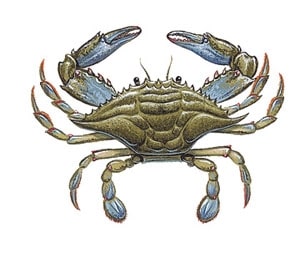
The /SWS/ Bait Encyclopedia
(Callinectes sapidus) Nicknames: blueclaw Target species: tarpon, black drum, redfish, cobia, permit Collecting: Dip-net surface swimmers or those crawling along the bottom in tidal creeks or along the flats. Vinyl-coated wire traps, loaded with frozen baitfish or carcasses, are another option. Check with state authorities for trap marking and deployment and crab size regulations. Live and fresh-dead crabs can also be purchased commercially from bait stores and fish markets along the Gulf and Mid-Atlantic coasts. Storing: Keep crabs in the live well or inside a small insulated cooler filled with a couple of inches of seawater. Throw in a couple of discarded fillets or dead baits and crabs can survive for days. Coin-sized permit crabs are best left overnight in floating bait buckets tied off to the dock-just make sure the tether rope is long enough to allow for tide changes. Keep fresh-dead crabs on ice in plastic bags. John Rice
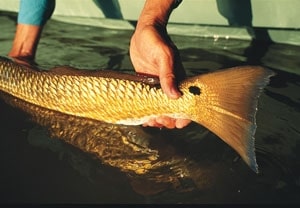
The /SWS/ Bait Encyclopedia
Rigging: Crab bodies are a top bait for black and red drum. Break off the claws and quarter the remaining shell using a heavy-bladed knife or meat cleaver on a cutting board. Hook the quarter section through the claw joint and soak it on the bottom on a slip-sinker rig. When sight-casting to tarpon and cobia, remove the pincher claws of live crabs and thread the hook just inside the end point up through the bottom and top shells. Pro Tip: For pitch-bait crabs for tarpon, cobia or permit, use an old hook or jig to puncture the shells to keep from dulling your hook point. During the hunt, allow the hooked crab to rest submerged in a few inches of sea water in a plastic pail. When a fish is spotted, cast just beyond its nose and free-spool the line. The crab will dive naturally and the fish will follow it down and pin it to the bottom. Scott Sommerlatte
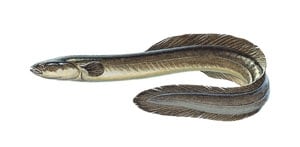
The /SWS/ Bait Encyclopedia
(Anguilla rostrata) Nicknames: snake, shoestrings, knot balls Target species: striped bass, cobia Collecting: With harvest restricted in the Mid-Atlantic, most eelers are gladly forking over greenbacks (the money, not the bait) for these prized baits. Eels can be trapped in fine-mesh wire traps in brackish or fresh water if the practice is legal. Storing: Eels are very hardy, but they tend to writhe into tight balls, making handling a pain. Gulf cobia anglers solve this problem by adding ice to a five-gallon bucket of seawater to slow the eels’ metabolism, making them docile. Once they hit the warm coastal water, though, they perk right back up-their action is near impossible for a big ling to ignore. If ice is in short supply, a small amount of sand in the bucket will also tranquilize them. John Rice

The /SWS/ Bait Encyclopedia
Rigging: Hook them under the chin and out the nose on a sliding egg sinker rig. For cobia cruising off the beach, forgo the sinker, make an accurate cast and hold on. Pro Tip: Keep hooked eels in a bucket of seawater or overboard to prevent them from tangling with the leader. And never, ever let an eel get anywhere near a coiled washdown hose or you’ll have the slimiest mess ever. Rodra C. Modra

The /SWS/ Bait Encyclopedia
(Opisthonema oglinum) Nicknames: greenie, greenback, threadfin Target species: sailfish, king mackerel, snook, snapper Collecting: Birds and surface commotion tip off the location of greenbacks and pilchards (whitebait), which are often intermixed. Toss balls of ground chum, fish oil, cat food or canned mackerel to draw herring into castnet range. A Sabiki rig in size six with green glow beads and fish-skin quills jigged around marker buoys is another dependable way to load up. Storing: Keep greenies in large, oval live wells that drain away waste and replenish with raw water. Cull dying baits often and save them for chum. John Rice

The /SWS/ Bait Encyclopedia
Rigging: Greenbacks are money. Fish them on the surface under kites to trigger strikes from sails and kings with the hook through the bait’s nostrils. Snook baits are rigged the same way on a 30- to 40-pound fluorocarbon leader up to 24 inches long. Free-line live herring into potholes and next to mangroves after limited chumming. Use 1/4- to 1/2-ounce plain-lead jigs run through the jaws to sink herring down the water column slowly when targeting snapper. Pro Tip: Don’t turn off the intended target by overfeeding. Use live chum sparingly. Start with several baits and then add a couple every so often to keep the fish interested. For greater enticement, bounce live herring off the engine cowling or pinch one eye to disorient the bait and cause it to flounder helplessly on the surface. Scott Sommerlatte
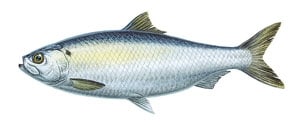
The /SWS/ Bait Encyclopedia
(Alosa aestivalis) Nicknames: herring, blueback, summer herring Target species: striped bass, bluefish Collecting: Jigging with chartreuse or white-quilled Sabiki rigs inside inlets is the typical way to gather blueback herring. Pinpoint schools on the fishfinder or watch for the fish to flip on the surface. Castnetting will also work when schools are thick, such as during the run to brackish water in the spring. Storing: Keep bluebacks in live wells or bait buckets to use for early season stripers and bluefish. John Rice

The /SWS/ Bait Encyclopedia
Rigging: Depending on the size of the herring, pin a 6/0 to 8/0 circle hook in front of the dorsal fin or the anal fin. The common rig includes a 15-inch section of 40- to 50-pound fluorocarbon leader tied to a barrel swivel attached to the main line. Pro Tip: Blueback herring are anadromous, meaning they live in salt water but run up rivers to spawn in the spring. If you have trouble finding schools in salt water, but a local fresh water river is experiencing a run, you can catch them there and use them in salt water-the quick change will not affect their liveliness. Many anglers transport them in live wells built out of coolers or washtubs with aerators powered by car batteries. Be sure to check local regulations before gathering bait. Tom Migdalski

The /SWS/ Bait Encyclopedia
(Fundulus majalis) Nicknames: bull minnow, killie, mudminnow, mummichog Target species: flounder, spotted seatrout, redfish, striped bass Collecting: Killifish are generally caught with small castnets along shorelines. Or make a trap by cutting the top off a three-liter beverage bottle. Perforate the bottle, throw in a few rocks and replace the cut-off top, inverted and duct-taped in place. Baited with pieces of fish, the trap will draw in killies that can’t find their way out the narrow neck. Storing: Mudminnows are tough. They’re perfectly content in small wells for hours. Flow-through bait containers or half-filled five-gallon buckets are handy alternatives to keep killies at the ready. Rigging: Use a sliding egg sinker rig with just enough weight to hold bottom. A small barrel or ball-bearing swivel holds the sinker above the leader and minimizes line twist, while a 15-inch section of 15- to 20-pound leader cuts down on abrasion from rocks and shells. Pro Tip: Sunglasses with polarized amber lenses are vital for castnetters to spot killifish in the shallows: The tan color and vertical markings on the bait allow them to blend in really well. In direct sunlight, shadows often tip off the location of the minnows before the baits are actually seen. If wading birds, such as heron or egrets, are stalking, killifish are the likely prey. After throwing the net, let it settle for several seconds before tugging on the main line to cinch the lead closed across the bottom-it will prevent any minnows from escaping. John Rice

The /SWS/ Bait Encyclopedia
(Scomber scombrus) Nicknames: mack, tinker mackerel, Boston mackerel Target species: tuna, sharks, striped bass, bluefish, black sea bass, grouper Collecting: Late March through early May is tinker season for Mid-Atlantic party boats running special charters to stock up on bait for the season. Tube rigs similar to Sabikis are popular for vertical jigging. Storing: When the stripers are keying on tinker schools close to the beach, live baits are effective. But most tinkers are vacuum-bagged and frozen for later use. John Rice
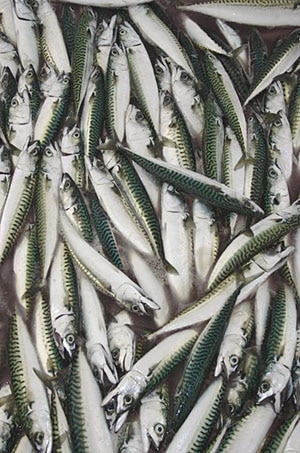
The /SWS/ Bait Encyclopedia
Rigging: Filleted strips are still fished for black sea bass or used for trolling baits. Chunked tinker work well for bluefish and tuna as both chum and bait. Sew double-hook rigs inside a whole mackerel with rigging floss to entice sharks. Pro Tip: Use mackerel strips to tip bucktail jigs for everything from dolphin to fluke, black sea bass to weakfish. Tougher than squid, these strips also give off a stronger odor and leave a prominent oil trail. Any leftover pieces that have been fished should be salted and added in with fresh strips-they’ll reabsorb oil and scent and be ready for the next trip. Darren Dorris

The /SWS/ Bait Encyclopedia
(Brevoortia tyrannus) Nicknames: mossback, pogy, bunker, fatback, peanut Target species: king mackerel, striped bass, tuna, sharks Collecting: Large-mesh castnets with heavy lead lines are necessary to ensnare pods of pogies. To find the schools, watch for surface-flipping or listen for popping sounds. Menhaden are typically found in off-color water, like tide lines near inlets or in stagnant back bays and bayous. In the Mid-Atlantic, anglers throwing weighted treble or snag hooks can snag individual baits from the school and cast them right back out to draw strikes from nearby bass. Storing: Vacuum-pack or use heavy-duty freezer bags to store fresh-dead bait for future use. Menhaden are damaged easily, so high-volume oval or round wells are vital for keeping live ones frisky. Don’t overload the well-with big bunker, stick to the one-bait-per-gallon rule. Check the water flow often and remove dead baits immediately. Keep the wells as full as possible to prevent sloshing and injury. Rigging: Nose-hook-and-stinger rigs work for kings, while stripers hit bunker with circle hooks through the back or as chunks on the bottom. Pro Tip: Pogy rigs for king mackerel require a minimalist approach. Use the lightest wire and hooks possible to keep the bait swimming naturally. The leader for the trailing stinger hook should be long enough to embed in the side of the tail without bending the bait. Change baits frequently, especially after a missed strike. John Rice
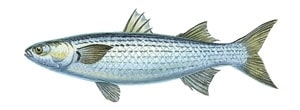
The /SWS/ Bait Encyclopedia
(Mugil cephalus) Nicknames: black mullet, buck mullet Target species: tarpon, redfish, marlin, flounder, jack crevalle Collecting: For small finger mullet, use a five- to eight-foot castnet with 3/8-inch mesh. Fast-moving adult mullet call for a ten- or 12-footer with a stretched mesh of at least 11/2 inches. When the fall migration is underway, cast snatch hooks into breakers. Storing: Mullet adapt to live wells or bait buckets, but cover them with a lid or towel or they’ll launch to freedom. Fresh-dead baits stay firm on ice. Rigging: Swimming mullet rigged with chin sinkers are favorite marlin baits. Chunks of mullet on fixed egg sinker rigs are the way to trophy reds. Pro Tip: Redfish expert Owen Lupton perfected a mullet-chunk rig that corrals oversize bulls and helps to release them healthy. Snell an 80-pound mono leader to a 10/0 circle hook, passing the leader through the hookeye on the same side as the point. Slip the leader through a crimp, a bead, an egg sinker, another bead and crimp and the eye of the main-line swivel. Pass it back through the crimps, beads and sinker, swaging the leader so it is just 3 1/2 inches long. The egg sinker will stop the red from swallowing the circle hook. John Rice
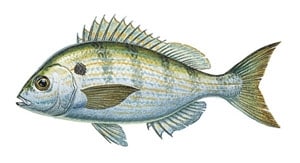
The /SWS/ Bait Encyclopedia
(Lagodon rhomboides) Nicknames: pinner, shiner, choffer, pin perch Target species: tarpon, snook, redfish, seatrout, grouper Collecting: Pinfish are typically found foraging in thick seagrass or around rocks and channel ledges. Use ultra-light tackle with small gold hooks and tiny pieces of shrimp or squid to catch them. Castnetting can also be productive, especially with frozen chum for enticement, or try around fish-cleaning stations. Storing: A recirculating live well is the best way to keep pinners frisky, but bait buckets or coolers will keep these durable baits as long as the water is changed frequently. John Rice

The /SWS/ Bait Encyclopedia
Rigging: Use appropriately sized Kahle or circle hooks through the nose, back or belly depending on the desired action. An inline float above the leader prevents the bait from hiding in the bottom grasses. Shiner tails are a Southern favorite-cut the tail section off a live pinfish and then split it in half to make two baits that release scent and have tail flash. Suspend under a short leader and clacker float to entice gator seatrout. Pro Tip: Vinyl traps are the easiest way to load up on pinfish before a trip. Fish carcasses or pierced cans of cat food or mackerel act as bait. With a couple of bricks for weight and a poly retrieval rope, soak the traps overnight. To prevent theft, use a clear-plastic beverage bottle with all the labels removed for a trap rope float. Clear plastic is tough to spot, yet easy to find by marking the trap location as a waypoint on your GPS. Scott Sommerlatte
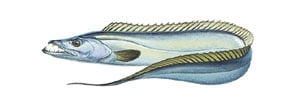
The /SWS/ Bait Encyclopedia
(Trichiurus lepturus) Nicknames: Atlantic cutlassfish, ribbon, silverfish Target species: king mackerel Collecting: Although ribbonfish are available frozen from bait shops, tournament pros prefer to catch their own. Ribbons like muddy bottom and sheltered water, so places like Cape Canaveral Harbor are ideal to load up on them. Use small pieces of shrimp on light tackle with dropper loops and minimal weight just off the bottom. Storing: The shinier the better, so handle ribbonfish carefully to keep from removing scales. Vacuum-seal them and stack flat in the freezer. John Rice

The /SWS/ Bait Encyclopedia
Rigging: A nose-hook jig run under the chin and through the forehead of the ribbonfish attaches to the wire leader. Stinger hooks are the rule with ribbons. Slow-troll them around structure and hang on. Pro Tip: Kingfish pro Dave Workman of Jacksonville, Florida, preps his ribbonfish by cutting off the pectoral fins to keep it from spinning on the troll. He uses a half-ounce chartreuse or pink jig pinned through the jaws as the lead hook, followed by two or three No. 4 treble stinger hooks. It’s all in the movement, so connect the stingers with No. 5 or No. 6 wire with just enough slack between them to ensure the bait “swims”¿ naturally. Scott Sommerlatte

The /SWS/ Bait Encyclopedia
(Sardinops sagax) Nicknames: ‘deens, salami Target species: tuna, albacore, dolphin, California yellowtail, calico bass, white seabass Collecting: Sardines can be caught on small, gold-hook Sabiki rigs with fish-skin quills and Flashabou, but most anglers simply buy scoops from bait pens. A scoop of a couple hundred prime ‘deens costs $20; tack on another ten bucks if the bait is scarce. Storing: Sardine scales flake off easily, so it’s best to minimize contact. Avoid baits with red eyes. “Green”¿ baits are those that have been in holding pens for just a couple of days, while “cured”¿ baits have survived and adapted to confinement for at least a week. Cured baits are resilient and will adjust easily to the boat live well. John Rice
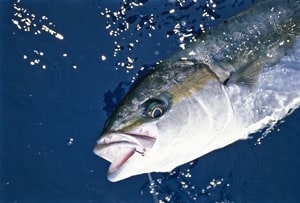
The /SWS/ Bait Encyclopedia
Rigging: A circle or J-hook threaded through the nostrils is the preferred rig. For albacore and other schooling fish that sound, pin the hook through the anal fin and the sardine will swim downward without any added weight. Pro Tip: With sardines, go light on presentation. Match the hook size to the bait. For baits four to six inches long, use ten- to 20-pound line and size 2 to 2/0 hooks. For bigger footlong salamis, use 20- to 50-pound line and 5/0 to 7/0 hooks. Light terminal tackle lets the bait swims naturally. Boyceimage.com
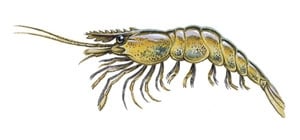
The /SWS/ Bait Encyclopedia
(Palaemonetes vulgaris) Nicknames: hopper, jumbo, prawn Target species: seatrout, redfish, snook, tarpon, snapper, bonefish Collecting: From the Carolinas south and across the Gulf of Mexico, dropping water temperatures and shorter days trigger the fall shrimp run. When water dips to the low 70s, castnet shrimp in tidal creeks and estuaries. Look out for shrimp flipping on the surface, or bait them into concentrations with fishmeal balls. To save time, most anglers open the wallet and buy live or fresh-dead shrimp instead. Storing: Submerging a bait bucket periodically will suffice, but aerated live wells keep shrimp frisky for hours. Just make sure all drains and overflows are screened or that one wayward shrimp will cause quite a stink after it rots for several days. Rigging: Shrimp are one of the most versatile baits available. They’re usually fished whole with a single hook piercing the horn (avoid the black dot with the hook point if you want it to stay alive), through the chin with a jighead or weedless with the hook point embedded inside the tail. Pinch the tail fins off to leave a scent trail. Chunks are also used with bottom rigs. Pro Tip: If you don’t have a live well or bait bucket, don’t fret. Put live shrimp in a plastic zipper bag, seal it tightly and throw the bag on ice in the cooler. The shrimp will literally chill out and go dormant (be careful not to let them come in contact with fresh water). When you’re ready for a bait, pull one out and rig accordingly. Once it hits that warm salt water, it’ll be hopping like usual. John Rice

The /SWS/ Bait Encyclopedia
(Illex illecebrosus) Nicknames: calamari Target species: swordfish, tuna, grouper, striped bass Collecting: Catch your own squid around dock lights at night or from the boat by submerging a Hydro-Glow light. They’ll be attracted to the plankton and other small baits the lights pull in. Cast squid jigs and retrieve in a jerky motion. It shouldn’t take long to load up. Storing: Use fresh-caught squid immediately or store on ice and freeze for later trips. John Rice

The /SWS/ Bait Encyclopedia
Rigging: Whole squid are the ultimate swordfish bait, either on the troll or drifting. But chunks or strips can be rigged in a variety of ways for a wide range of gamefish, from grouper to striped bass. Pro Tip: Pin a fresh squid on a 7/0 or 8/0 wide-gap circle hook tied to a 50-pound fluorocarbon leader with a heavy enough sliding egg sinker to hold bottom. Drop it over natural rock formations or an artificial reef and hold on. Big smoker kingfish will wolf down squid quicker than you can say “marinara sauce,”¿ and the circle hook sticks in the corner of the jaw so the leader stays intact. Danny Moody








